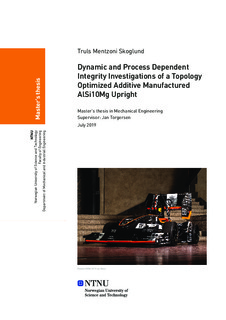| dc.contributor.advisor | Torgersen, Jan | |
| dc.contributor.author | Skoglund, Truls Mentzoni | |
| dc.date.accessioned | 2019-11-10T15:00:29Z | |
| dc.date.available | 2019-11-10T15:00:29Z | |
| dc.date.issued | 2019 | |
| dc.identifier.uri | http://hdl.handle.net/11250/2627528 | |
| dc.description.abstract | Additiv tilvirkning muliggjør for tilvirkning av komponenter med organisk geometri. Kombinert med strukturell optimalisering, kan nye komponenter med lav vekt optimalisert for å takle spesifikke lastsitasjoner produseres. Denne oppgaven presenterer hele design- og produksjonsprosessen for tre strukturelle uprights (hjulopphengsnav/spindler) for en enkel-seter, formel-aktig bil. Upright er en kompleks brakett. Den huser en planetarisk girkasse og overfører alle krefter fra kontaktflaten til dekket og inn i chassiset. Ved å benytte strukturell optimalisering er det oppnådd et godt kompromiss mellom vekt og stivhet. Fremre og bakre upright veier henholdsvis 585 og 530 gram, som gir en total vektreduksjon på 160 gram sammenlignet med fjorårets utgave. Den laterale deformasjonen i ytre sving med en hastighet på 120 km/t var på 0.117 mm (fremre) og 0.15 mm (Bakre). Siden 2014 har uprightene blir additivt tilvirket i titanlegering TiAl6V4 i Revolve NTNU. I år var det første året hvor uprightene ble produsert i aluminiumslegering AlSi10Mg. Ved å vurdere forskjellig materialer har det vist seg at den geometriske stivheten har en større innvirkning på komponenten enn materialets stivhet.
Det dynamiske belastningsspekteret for en upright er analysert og fire kvasistatiske lastsituasjoner fra loggdata gjennom 2018 sesongen, er blitt laget. Loggdataene er grunnlaget for tretthetsundersøkelser som viser at uprighten er dimensjonert for 61 timers aktiv testkjøring av bilen, som er over dobbelt så mye som kravet
I alt åtte strekkprøver ble fremstilt i vertikal og horisontal retning for å validere material-egenskapene til AlSi10Mg. Verdiene for flytegrense og bruddfasthet er noe unøyaktige for de horisontal-produserte prøvene på grunn av de var utilstrekkelig festet i strekkmaskinen. Strekklapper ble benyttet under forsøket, og den utilstrekkelige innfestingen påvirket ikke elastisitetsmodulen og Poisson‘s-forholdet, hvilket gir pålitelige resultater for disse to parameterne. Elastisitetsmodulen var imidlertid 72,8 og 64,4 GPa i henholdsvis horisontal og vertikal tilvirkningsretning. Ellers var Poisson forholdet 0,341 og 0,328 for vertikal og horisontal retning. Disse parameterne definerer materialet under optimaliseringen og kan brukes i fremtidige studier, hvor enda lavere sikkerhetsfaktorer og mer komplekse geometrier kan oppnås ved å optimalisere utformingen av uprighten. | |
| dc.description.abstract | Additive manufacturing allows for organic shapes and combined with structural optimization, new lightweight components optimized to cope with specific mechanical loading scenarios, are possible. This thesis presents the entire design and manufacturing process of three structural AlSi10Mg uprights for a single-seat formula-style race car. The upright is a complex bracket. It houses the planetary gearbox and propagates all forces from the contact patch of the wheels into the chassis. By utilizing structural optimization, a good compromise between weight and stiffness has been achieved. With a weight of 585 and 530 grams, front and rear upright, respectively, a total weight reduction of about 160 grams in total has been achieved. The lateral deformation during outer cornering in 120 km/h was 0.117 mm (front) and 0.15 mm (Rear), respectively. Since 2014, the uprights have been additively manufactured in titanium alloy TiAl6V4 at Revolve NTNU. For the first time, the uprights were produced in aluminium alloy AlSi10Mg. By evaluating different material, it has been found that geometric stiffness has a more significant impact on the stiffness of the component than the material stiffness.
The dynamic loading spectrum for an upright has been analyzed and broken down to four quasi-static load cases based on log data from the 2018 session. The log data are the basis for fatigue investigations and the prediction showing that the upright is dimensioned for 61 hours of active testing, which is twice the requirements.
A total of eight tensile specimens was fabricated in the vertical and horizontal direction for validating the material properties of AlSi10Mg. The yield and ultimate tensile strength are slightly inaccurate for the horizontal printed samples due to inadequate clamping of the specimens in the tensile machine. Strain gauges were used during the experiment. Thus the inadequate clamping did not affect Young's modulus and Poisson's ratio, and reliable results for these parameters were achieved. The Young's modulus resulted in 72.8 and 64.4 GPa for horizontal and vertical print orientation, respectively. Poisson's ratio counted in 0.341 and 0.328 for the respective directions, respectively. Young's modulus and Poisson's ratio define the material in the optimization and can be used for future studies, where the optimization might be pushed to even lower safety factors and more complex geometries. | |
| dc.language | eng | |
| dc.publisher | NTNU | |
| dc.title | Dynamic and Process Dependent Integrity Investigations of a Topology Optimized Additive Manufactured AlSi10Mg Upright | |
| dc.type | Master thesis | |
